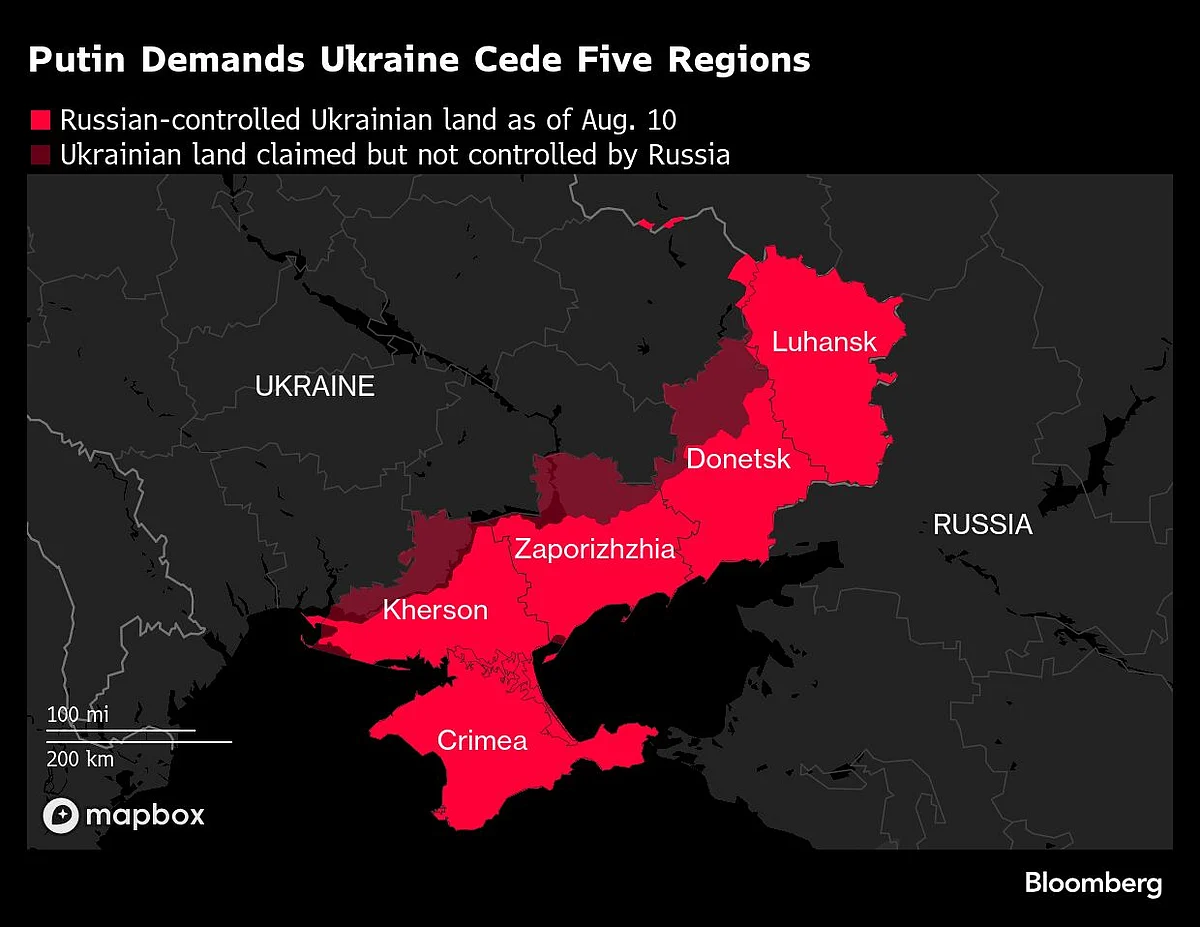Trump Aims To Set Putin-Zelenskyy Meeting After Monday Summit
“We are ready for a trilateral,” Zelenskyy said, adding that his country still needs support from both the US and European allies.

US President Donald Trump said he hoped to secure an agreement for a trilateral meeting with Vladimir Putin and Volodymyr Zelenskyy as he welcomed the Ukrainian leader to the White House for high-stakes talks on bringing an end to Russia’s war on Ukraine.
“If everything works out well today we’ll have a trilat and I think there will be a reasonable chance of ending the war when we do that,” Trump told reporters Monday during an Oval Office meeting with Zelenskiy.
Trump has accelerated his push to stop a conflict that has persisted despite months of US diplomatic efforts and his campaign-trail vow to end it on his first day in office. The tone between the two leaders was notably improved from Zelenskiy’s last visit to the Oval Office in February, which erupted into a bitter public clash with Trump and briefly led to the US halting military support.
“We are ready for a trilateral,” Zelenskiy said, adding that his country still needs support from both the US and European allies.
Despite the friendly tone, the risks for Ukraine are even more intense this time around. Trump dropped his demands for a ceasefire as a condition for further talks last Friday after meeting with Putin and backed off his threat of imposing punitive measures on Moscow, aligning himself with the Kremlin’s position that negotiations with Ukraine should focus on a long-term settlement.
Trump said he would encourage Zelenskyy to strike a deal, raising the prospect of Kyiv being forced into making unpalatable territorial concessions. European leaders headed to the White House as a show of support for Ukraine.
“I think that’s true,” Trump said when asked if he believes Zelenskyy can end the war.
The US president sidestepped a question about what kind of security guarantees the US could provide Ukraine — a key ask from Kyiv — but said any deal would provide a lasting peace.
Following their bilateral meeting, Trump and Zelenskyy will be joined for talks with German Chancellor Friedrich Merz, French President Emmanuel Macron, UK Prime Minister Keir Starmer, Italian PM Giorgia Meloni and European Commission President Ursula von der Leyen. Among the visitors are individuals Trump has struck a personal rapport with, including NATO Secretary General Mark Rutte and Finnish President Alexander Stubb.
“We love them,” Trump said when asked by a reporter earlier, while shaking hands with Zelenskyy and welcoming him to the White House, for his message to the Ukrainian people.
Zelenskyy this time arrived for the talks wearing a jacket, but without a tie, a change from the war fatigues he has donned since Russia invaded his country in 2022, attire which Trump allies called a mark of disrespect during his last meeting with the US president.
“It’s the best I have,” Zelenskyy said, referring to his outfit.
“I love it,” Trump said.
Tense Negotiations
The mood going into the meeting has been tense following Trump’s summit with Putin, whose full-scale invasion of Ukraine has left Europe facing its deadliest conflict in decades. The US president has shifted his focus from Putin to Zelenskiy, saying in a social media post before the talks that the Ukrainian leader “can end the war with Russia almost immediately, if he wants to, or he can continue to fight.” He suggested that the Crimean peninsula would not be returned and said Ukraine wouldn’t be allowed to join NATO, without providing further details.
The Ukrainian president responded in a post on X that Putin used Crimea and the part of the eastern Donbas region he had seized in 2014 “as a springboard for a new attack” in February 2022. “Russia must end this war, which it itself started,” he wrote.
Zelenskiy and his European allies will try to steer Trump away from forcing overly costly territorial concessions on Kyiv, which the White House seems to be focusing on in its drive to achieve a quick peace deal. They will also seek to pin down possible security guarantees resembling NATO’s Article 5 mutual defense clause that the US may be open to providing to ensure Ukraine’s protection from future aggression.
In his calls with European leaders after the Alaska summit, Trump said Putin wants Ukraine to cede control of its entire Donbas region of the Donetsk and Luhansk provinces, renewing earlier demands. That would hand Russia a victory it has been unable to achieve militarily since fighting first erupted in 2014, and in an area where Ukraine retains heavily-fortified defenses.

Russia would also halt advancing its claims over the parts of Ukraine’s Zaporizhzhia and Kherson regions that it doesn’t now control, effectively freezing the battle lines at current positions. The Kremlin could also potentially withdraw troops from areas of northeastern Ukraine near the Russian border where its forces control only small pockets of land.
That raises the prospect that the “land-swapping” Trump has teased as part of any deal will be lopsided in Putin’s favor by giving him control of areas beyond what he’s seized, offset by modest concessions of land that had been Ukraine’s anyhow.
Trump also told allies he would urge Ukraine to agree to a deal, with the goal of holding a Putin-Zelenskiy meeting within a week. That’s a timeline that many of the Europeans regard as too aggressive, given how many issues remain unresolved.
Russia, meanwhile, has continued to make slow but steady advances in eastern Ukraine. Hours after Zelenskiy arrived in Washington, Russian attacks on the Ukrainian cities of Kharkiv and Zaporizhzhia killed at least 10 civilians, including two children, and injured dozens, according to local authorities.

